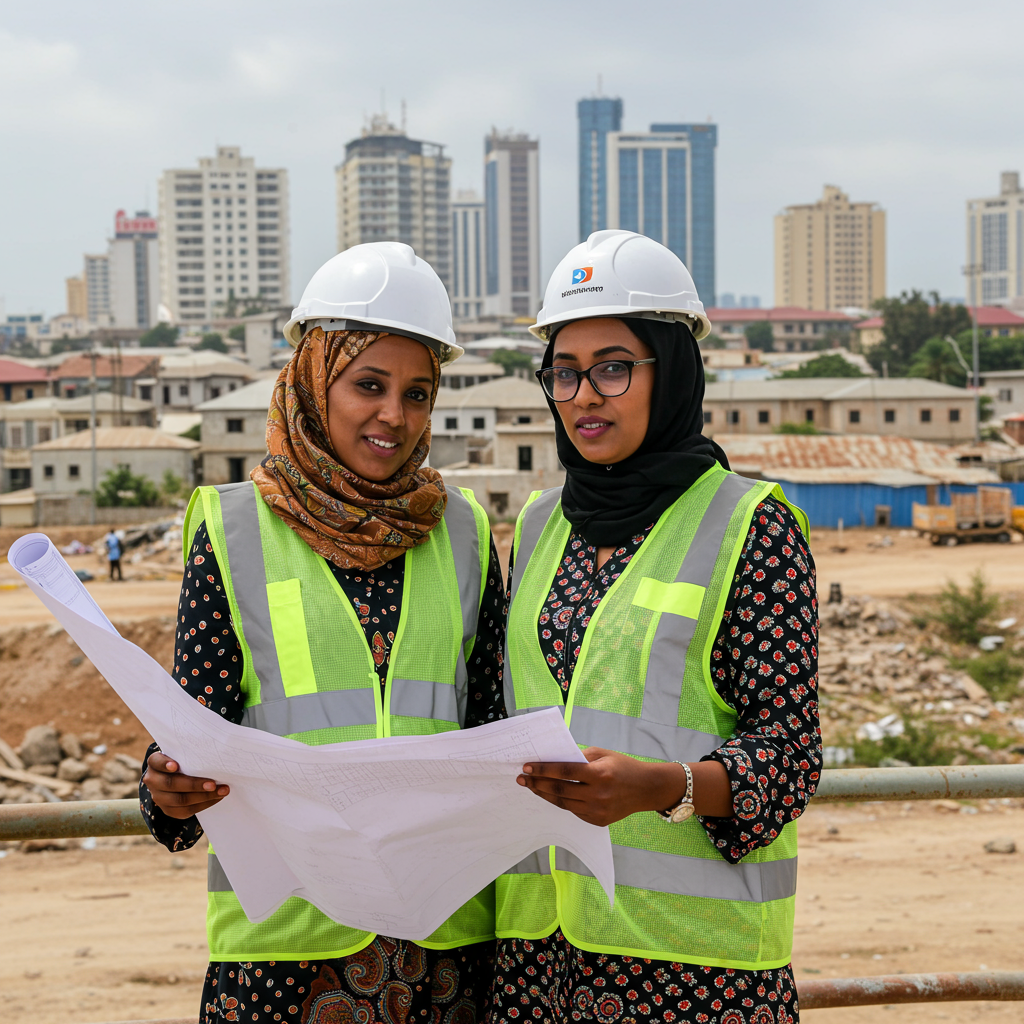Mogadishu, Somalia’s vibrant capital, is experiencing a dramatic transformation. Rising literally and metaphorically from the difficult legacy of decades of conflict, the city is undergoing a remarkable construction boom. This surge in development isn’t just changing the skyline; it’s creating unprecedented opportunities, particularly for women in fields traditionally dominated by men.
At the forefront of this change are young engineers like Fathi Mohamed Abdi and Saadia Ahmed Omar. Both aged 24, they represent a new generation determined to rebuild their nation. For the past five years, they have been integral to Mogadishu’s reconstruction, having already overseen more than 30 multimillion-dollar projects. Currently, they are managing the construction of a 10-floor apartment complex in the Taleh area of Hodan District, a testament to their growing influence and skill.
Navigating a Male-Dominated Field
Working on site, wearing hard hats and issuing instructions to predominantly male teams, Fathi and Saadia faced initial skepticism. “When I started, people doubted me,” Fathi Mohamed Abdi, who serves as chief operating officer for Somali-owned Arkan Engineering Services, told the BBC. Questions like “‘How can we trust a house built by a woman?'” and “‘How can I trust my money and property with a young female engineer?'” were common.
Their journey hasn’t been easy. Women constitute a mere 5% of engineers in Somalia. Saadia Ahmed Omar recalls the struggle to find opportunities early in her career. “When I applied for internships, most companies rejected me,” she shared, citing doubts about a woman’s ability to handle the physical demands of engineering. She spent three months searching before finally getting a chance.
Despite these hurdles, driven by a deep connection to their city and country, they persevered. Both women were born during the civil war and witnessed the nation’s fragmentation. While many left, they chose to stay, fueled by a passion to contribute to rebuilding, even as challenges like the al-Shabab insurgency persisted.
Demand Creates Opportunity
The sheer scale of the rebuilding effort is a key factor opening doors for women. “Mogadishu needs us,” Saadia asserts. “When I was young, this city was in chaos. Now, we are part of its reconstruction.” She believes the high demand for skilled professionals has created space for women where none existed before.
Ibrahim Abdi Heyle, chairman of the Somali Engineers Association, echoes this sentiment. The significant increase in infrastructure, energy, and technology projects means a substantial workload. The association is actively encouraging and welcoming greater participation from women, recognizing them as vital to filling critical workforce gaps and bringing diverse perspectives and innovative solutions to the industry.
A City Transformed
The evidence of this boom is visible across Mogadishu. According to the mayor’s office, over 6,000 buildings have been constructed in the last five years. This surge is largely attributed to improved security and substantial investments from the Somali diaspora. Remittances from abroad accounted for a significant 16.7% of Somalia’s GDP in 2022, according to the World Bank, directly fueling opportunities for architects and engineers. The skyline is now increasingly dotted with cranes and scaffolding, replacing the visible scars of conflict that once defined districts like Shangani, where bombed-out buildings were commonplace.
For Fathi and Saadia, seeing the city evolve is a source of immense pride. “The city is now home to taller buildings and modern infrastructure, a stark contrast to the Mogadishu of the past,” Fathi states. “We are proving that women can not only design buildings but also lead projects and shape the city.”
Challenges Amidst Rapid Growth
However, this rapid urban transformation is not without its critics and significant challenges. Veteran architect Siidow Cabdulle Boolaay voices concern over the loss of Mogadishu’s historical character and its once structured urban planning, lamenting the replacement of beautiful Italian-style architecture.
More critically, he raises serious safety and quality control issues. A widespread practice involves using salty sand from Somalia’s coast for construction, a method discouraged globally due to the risk of steel corrosion. Boolaay also points to a lack of essential safety features in many new high-rises, including inadequate fire extinguishers and potentially faulty electrical installations. He worries the sheer pace of construction compromises quality.
The mayor’s office acknowledges past issues, stating that regulations and quality control have been strictly enforced only for the last three years, leaving older constructions potentially problematic. They are also developing new laws to guide urban planning and zone high-rise construction. However, concerns persist about the capacity for consistent follow-up checks given the speed of the boom.
Beyond building integrity, the rapid urbanization strains existing infrastructure. Mogadishu lacks a proper sewage system, and the proliferation of unregulated borehole drilling for each new building risks severely depleting groundwater reserves. Christophe Hodder, a UN climate security and environmental adviser, warns that without a coordinated water management approach, the city faces a potential water crisis. This density, exacerbated by people moving to the city due to drought and conflict, further pressures resources and risks increasing social disparities.
Building Hope and Resilience
Despite these complex challenges, a spirit of resilience and hope prevails. The Somali Engineers Association remains optimistic, even when buildings they designed are targeted by al-Shabab attacks. Chairman Ibrahim Abdi Heyle notes that Somalis, particularly engineering students, have become resilient. “A lot of explosions happened; our dreams did not stop on that. Today we are reviving the engineering profession, which collapsed 30 years ago. That means there is hope.”
The ambition is clear: to see Mogadishu become a modern city and a model for post-conflict reconstruction within five years. For Saadia, the transformation is deeply personal. “When I walk through the streets and see buildings I helped construct, I feel proud,” she says. “We are not just building structures; we are building hope.” Fathi agrees, highlighting the crucial role women play in this hopeful future. Mogadishu’s rise is a story of concrete, steel, and above all, determination.




